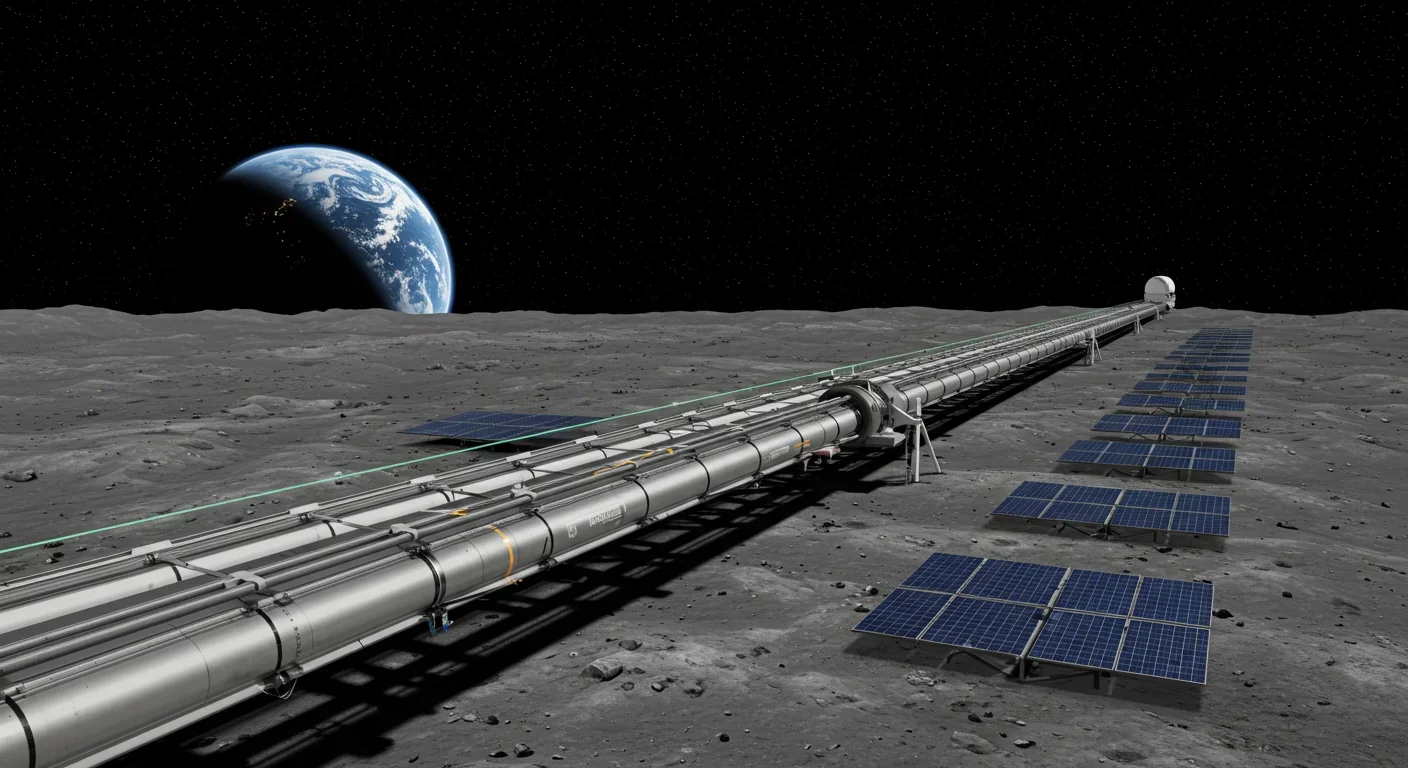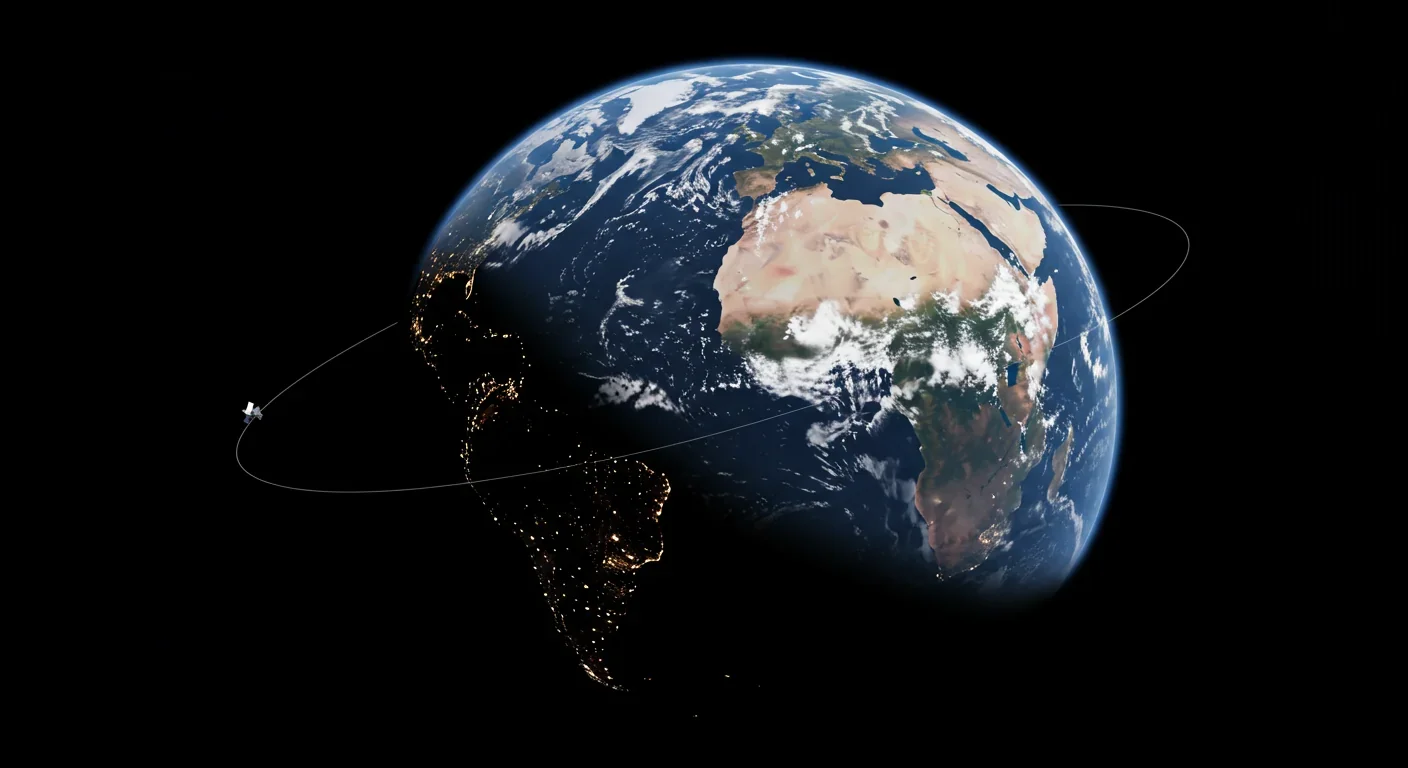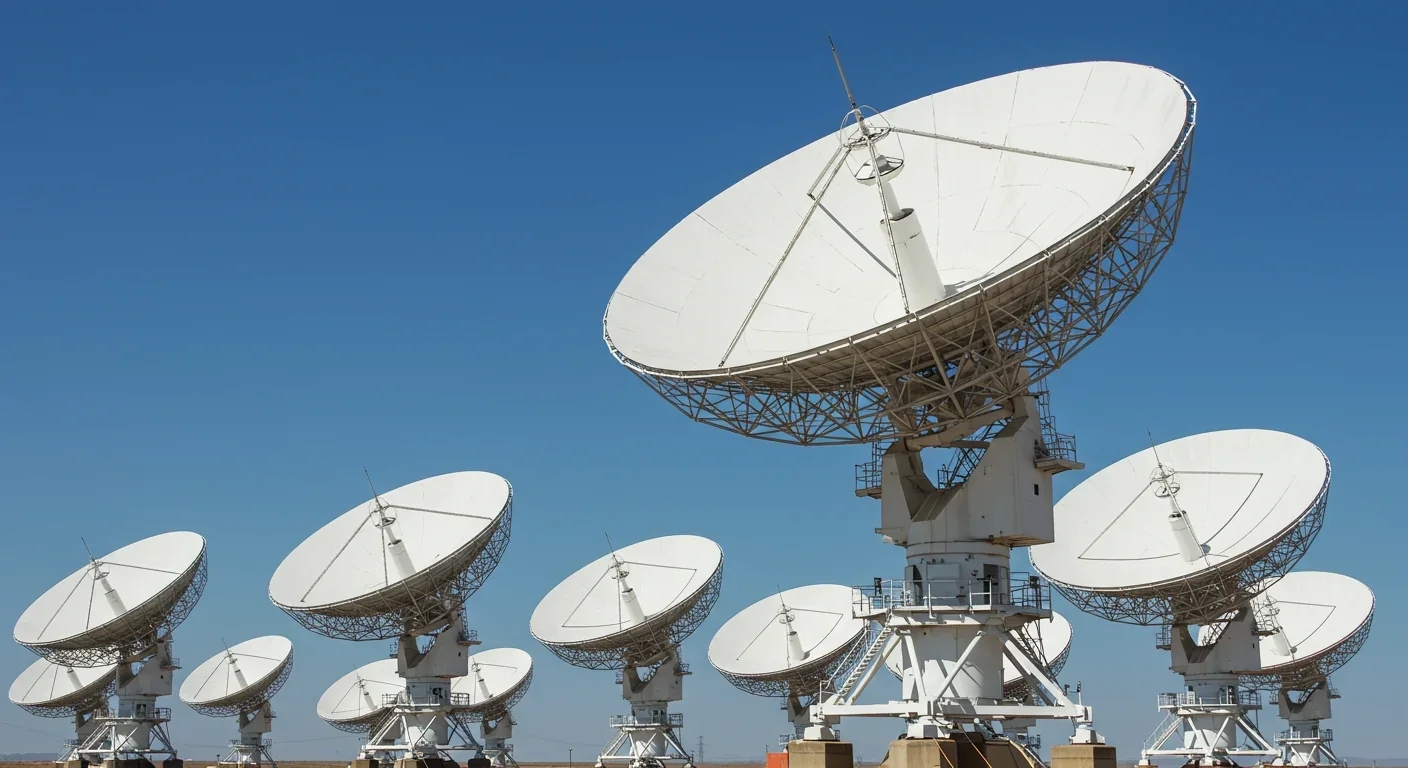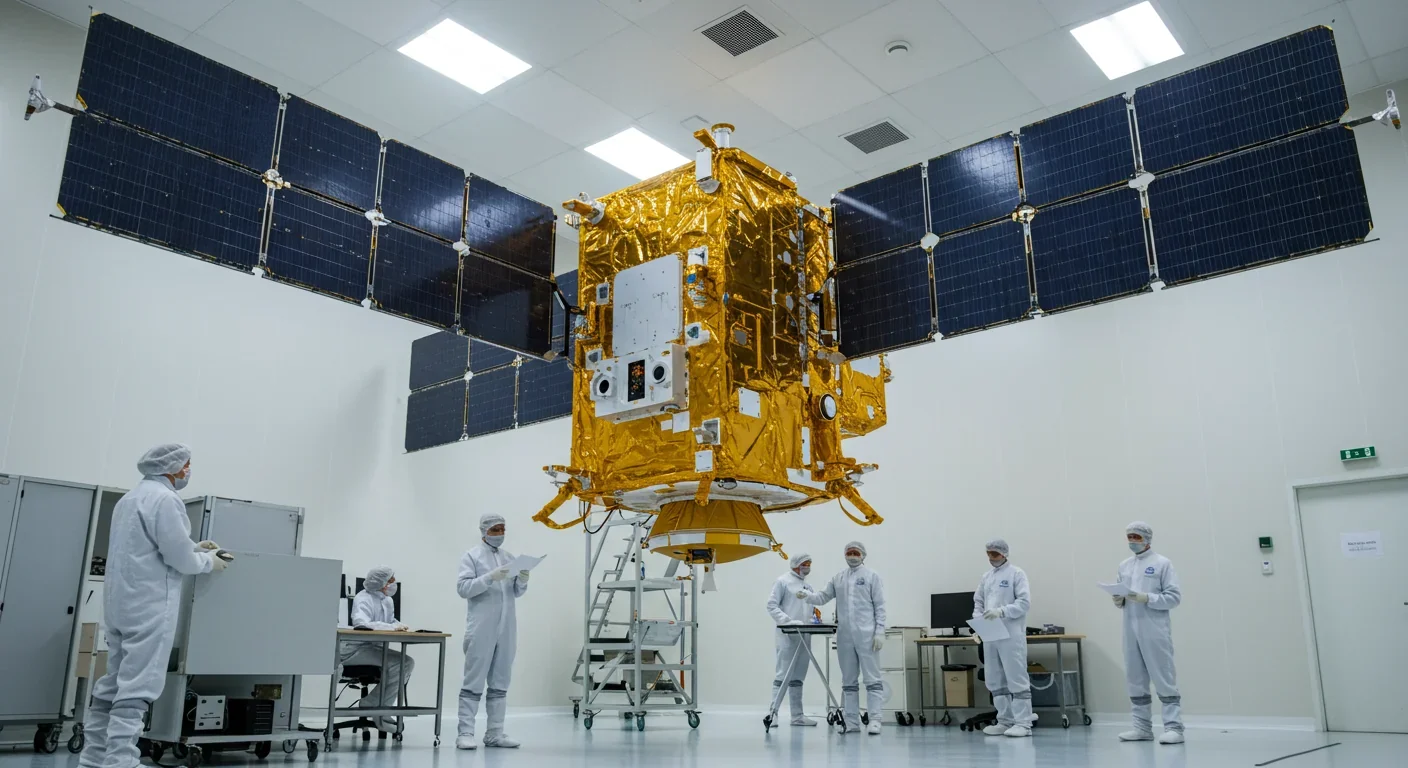Lunar Mass Drivers: Moon Catapults for the Space Economy

TL;DR: Geosynchronous orbit positions 22,236 miles above Earth represent premium space real estate worth hundreds of millions per slot. With only 1,800 positions available, orbital economics balances physics-imposed scarcity, international governance, and fierce competition.

In Manhattan, a square foot of prime real estate might cost $5,000. In Hong Kong, luxury properties command similar prices. But 22,236 miles above Earth's equator, a single orbital position—essentially a point in space—can be worth hundreds of millions of dollars. Welcome to the economics of geosynchronous orbit, where the laws of physics create artificial scarcity and nations compete for positions that most people will never see.
At precisely 35,786 kilometers above Earth's equator, something remarkable happens. A satellite placed at this altitude takes exactly 24 hours to complete one orbit—matching Earth's rotation perfectly. From the ground, these geostationary satellites appear to hover motionlessly over a fixed point, making them ideal for communications, broadcasting, weather monitoring, and military surveillance.
This isn't magic. It's orbital mechanics. The altitude creates a perfect balance between gravitational pull and centrifugal force. Go lower, and satellites orbit faster than Earth spins. Go higher, and they lag behind. Only at this precise distance does the synchronization occur.
The operational advantages are enormous. Ground stations don't need to track moving targets across the sky. A fixed antenna can maintain constant contact with the satellite. For television broadcasters, telecommunications companies, and weather agencies, this continuous line of sight is worth its weight in gold—or rather, its position in space.
Here's where economics meets orbital physics. That magic altitude forms a ring around Earth's equator—approximately 265,000 kilometers in circumference. Satellites need separation to avoid interference from their radio signals and physical collisions. Current International Telecommunication Union regulations typically require spacing of 2-3 degrees for satellites operating in the same frequency bands.
Do the math: 360 degrees divided by 2-3 degrees per slot equals roughly 120-180 prime positions. Factor in frequency coordination, and the total capacity expands to around 1,800 operational positions. That's the entire supply. No amount of money or technology can create more geostationary orbit.
Only about 1,800 orbital positions exist in geosynchronous orbit—making it one of the most constrained resources in human infrastructure. Unlike terrestrial real estate, no amount of investment can expand this supply.
As of 2024, approximately 580 operational satellites occupy GSO, with hundreds more positions claimed but not yet filled. The scarcity is real, the competition fierce, and the valuations astronomical. When Intelsat acquired PanAmSat in 2006, the deal valued individual orbital slots and associated spectrum rights at $100-200 million each. More recent transactions suggest premium positions have only increased in value.
You can't exactly call a real estate agent to secure an orbital slot. Instead, you navigate one of the world's most complex regulatory frameworks, governed by the ITU Radio Regulations.
The process begins with advance publication. A country or operator files a request with the ITU's Radiocommunication Bureau, identifying the desired orbital position and spectrum frequencies. This starts a coordination period where the applicant must negotiate with operators of neighboring satellites to prevent interference.
These coordination agreements can take years. Operators must demonstrate that their satellite won't disrupt existing services—or reach financial settlements with those it might affect. The negotiations involve precise calculations of beam patterns, power levels, and frequency management.

Once coordination succeeds, the assignment gets registered in the Master International Frequency Register—essentially the deed registry for space. This registration creates internationally recognized rights over a specific orbital slot and spectrum band, rights that can be traded, leased, or sold.
But here's the catch: you must launch a satellite within seven years of filing, or you lose your claim. This "use it or lose it" rule prevents speculation but creates its own problems. Operators sometimes launch minimal satellites just to preserve valuable positions, planning to replace them with full-capability spacecraft later.
Like any scarce resource with unclear ownership boundaries, GSO positions have spawned a thriving secondary market. Established operators lease capacity to smaller companies. Countries with valuable equatorial positions sometimes host foreign satellites in exchange for fees or free capacity.
The Kingdom of Tonga, for instance, generated millions by registering and leasing orbital slots aligned with its Pacific territory. Luxembourg has built an entire space industry around favorable regulatory treatment of satellite operators. These nations recognized that their geographic position—in Tonga's case, lying under a sparsely populated portion of the GSO arc—had inherent value.
Mergers and acquisitions in the satellite industry often revolve around orbital assets as much as physical spacecraft. When companies like SES, Intelsat, or Eutelsat acquire competitors, they're buying portfolios of orbital rights that took decades to coordinate and cost hundreds of millions to establish.
"The Kingdom of Tonga generated millions by registering and leasing orbital slots. Some nations recognized that their geographic position under the GSO arc had inherent economic value."
— Space Industry Analysts
Not all GSO slots are created equal. Several factors drive valuation:
Geographic coverage: Positions that can see both North America and Europe command premium prices. Slots over the Atlantic or Indian Oceans enable trans-continental communications and serve the world's largest economies. By contrast, positions over the Pacific may have excellent Asia-Pacific coverage but limited visibility to other markets.
Frequency availability: Spectrum is allocated through a complex matrix of frequency bands and geographic zones. The most valuable positions offer access to multiple frequency bands—C-band for reliability, Ku-band for capacity, Ka-band for high-throughput applications. A slot with clean spectrum—free from interference and overlapping claims—is worth substantially more than one requiring constant coordination.
Existing infrastructure: Ground stations, gateway facilities, and customer equipment represent sunk costs. Operators pay premiums for positions where they already have terrestrial infrastructure. Launching a satellite to a new orbital location might require building entirely new ground networks.
Regulatory certainty: Some positions involve ongoing disputes or unclear rights. Slots with clean regulatory status, strong coordination agreements, and stable national backing command higher valuations.
Just as skyscrapers let Manhattan pack more real estate into limited space, technology is increasing the effective capacity of GSO. But unlike urban development, you can't build upward in space—you have to get smarter about using the positions you have.
Electric propulsion has emerged as a game-changer. Traditional chemical propulsion systems carry tons of fuel, limiting satellite lifespan to 15 years before they run out of station-keeping propellant. Modern electric propulsion systems like Hall effect thrusters use xenon gas and electricity, operating 5-7 times longer than conventional systems.

This extended lifespan directly increases slot value. A satellite that operates for 25 years instead of 15 generates 67% more revenue from the same orbital position. NASA's Small Spacecraft Electric Propulsion system can even enable "tug" services—docking with aging satellites to extend their missions long after their original propulsion systems fail.
Software-defined satellites represent another efficiency leap. Traditional spacecraft are built for specific missions: broadcasting, communications, or data relay. If market conditions change, tough luck—you're stuck with hardware designed for yesterday's needs.
Software-defined satellites change this calculus. They can reconfigure their beams, adjust coverage areas, and even switch between different services in orbit. An operator might launch a satellite for video distribution but reprogram it for high-throughput internet if that market proves more lucrative. This flexibility makes each orbital slot more valuable because the asset can adapt to changing economics.
High-throughput satellites pack more capacity into the same slot through frequency reuse and spot beam technology. Instead of a single broad beam covering an entire continent, modern satellites use dozens or hundreds of narrow beams, each reusing the same frequencies in different geographic areas. This spatial reuse can increase capacity 10-20 times compared to conventional designs.
Electric propulsion extends satellite lifespans from 15 to 25+ years, directly increasing the economic value of each orbital position by 67% or more through extended revenue generation.
If you follow space industry news, you've heard about low Earth orbit mega-constellations. SpaceX's Starlink has launched over 5,000 satellites. Amazon's Project Kuiper plans thousands more. OneWeb is operational. These LEO constellations promise global coverage, low latency, and seemingly unlimited capacity.
So why hasn't this flood of LEO satellites crashed the GSO real estate market?
Physics and economics both provide answers. LEO satellites orbit at just 300-1,200 kilometers altitude, racing around Earth every 90-120 minutes. Each satellite sees any given ground location for only a few minutes before disappearing over the horizon. Providing continuous coverage requires massive constellations—hundreds or thousands of satellites working in coordination.
This creates fundamental trade-offs. LEO excels at low-latency communications—crucial for applications like video calls or financial trading. The shorter distance means signals take just 10-30 milliseconds to reach orbit and return, compared to 500+ milliseconds for GEO.
But GSO offers advantages that LEO can't match. A single geostationary satellite provides 24/7 coverage to an entire hemisphere—about 40% of Earth's surface. LEO requires dozens of satellites to achieve similar continuous coverage of just one continent. For applications like broadcasting, weather monitoring, or maritime communications, GSO's simplicity and reliability remain unbeatable.

The economics matter too. LEO constellations require continuous investment—satellites deorbit naturally after 5-7 years due to atmospheric drag, so the entire fleet needs constant replenishment. GSO satellites, safely above atmospheric effects, can operate for 15-25 years without replacement.
Different markets favor different orbits. Broadcasting will likely remain GSO-dominated. Mobile backhaul and maritime communications favor GSO's wide coverage. Consumer internet and enterprise connectivity are shifting toward LEO. The future isn't winner-take-all; it's market segmentation based on technical requirements and economic trade-offs.
Space might be vast, but GSO is feeling crowded. Every satellite eventually reaches end-of-life, and dead spacecraft become hazards. At geostationary altitude, there's no atmospheric drag to naturally clear debris. Objects stay there essentially forever unless actively removed.
Current regulations require operators to boost defunct satellites to "graveyard orbits" 200-300 kilometers above GSO. This frees the operational slot but creates a growing shell of space junk just above the premium real estate. Over 600 defunct satellites now occupy these graveyard orbits, with more added each year.
Even small debris poses risks. A collision at orbital velocities can shatter satellites into thousands of fragments, creating cascading dangers. Unlike LEO, where debris eventually falls back to Earth, GSO debris persists indefinitely. The potential for collisions threatens the long-term sustainability of the orbital environment.
This has spurred innovation in end-of-life solutions. Some operators are experimenting with active debris removal—spacecraft designed to capture and deorbit defunct satellites. Others are developing in-orbit servicing capabilities—robotic spacecraft that can refuel, repair, or reposition aging satellites, extending their useful lives and reducing the need for replacement launches.
"At geostationary altitude, there's no atmospheric drag to naturally clear debris. Objects stay there essentially forever unless actively removed—creating a permanent hazard layer above our most valuable orbital real estate."
— Space Debris Researchers
GSO isn't just an economic resource; it's a strategic one. Nations recognize that communications infrastructure represents sovereign capability. Depending entirely on foreign satellites for critical communications creates vulnerabilities.
This has driven emerging space nations to secure their own GSO positions. India operates the GSAT constellation for domestic communications and broadcasting. China has invested heavily in DFH series satellites. The Middle East, Southeast Asia, and Latin America have all launched national or regional satellite programs.
The ITU's coordination process was designed for a world of relatively few space actors—primarily the US, Soviet Union, and Europe. Today's environment, with dozens of nations and hundreds of commercial operators, strains the system. Coordination disputes can become proxy battles for larger geopolitical tensions.
Some nations have filed for far more orbital slots than they could plausibly use, effectively squatting on positions to preserve future options. Others contest the "first come, first served" principle embedded in ITU rules, arguing it unfairly advantages established space powers. These debates about fairness, access, and governance will intensify as GSO becomes more congested.

Military applications add another layer of complexity. Geostationary satellites provide crucial capabilities for early warning, signals intelligence, and secure communications. The US operates several classified GSO spacecraft for these missions. Other nations with strategic ambitions seek similar capabilities, driving demand for orbital positions with specific geographic coverage.
Will GSO remain prime space real estate, or will it decline like downtown shopping malls facing e-commerce competition?
The answer depends on how you value different attributes. For sheer communications capacity measured in bits per second, LEO constellations are winning. SpaceX's Starlink already provides service to over 2 million customers globally—growth that would require dozens of new GSO satellites.
But GSO retains structural advantages that ensure continued relevance. Broadcasting and direct-to-home television still reach hundreds of millions of households globally via GSO satellites. Weather agencies depend on continuous monitoring that only geostationary satellites provide. Maritime and aviation communications favor GSO's simplicity.
The market is bifurcating rather than replacing. Total GSO satellite revenue has remained relatively stable around $60-80 billion annually even as LEO capacity explodes. What's changing is the composition—less consumer internet, more specialized applications where GSO's unique characteristics justify premium pricing.
Investment patterns reveal confidence in GSO's future. Major operators continue ordering new satellites at costs of $200-400 million per spacecraft. These aren't last-gasp attempts to preserve dying assets—they're calculated bets that GSO will generate returns for decades to come.
The secondary market for orbital rights remains active, with positions changing hands at valuations that reflect long-term value. If investors truly believed LEO would make GSO obsolete, we'd see fire-sale prices. Instead, premium positions continue commanding nine-figure valuations.
Since we can't create more GSO, operators are maximizing what they have. The latest satellites pack extraordinary capability into each orbital slot.
ViaSat-3 class satellites, for instance, provide 1 terabit per second of throughput—more than many older GSO satellites combined. This lets operators deliver more services from fewer slots, effectively increasing the economic efficiency of scarce orbital positions.
Co-location strategies let multiple satellites share the same nominal position, separated by just 0.1 degrees and carefully managed collision avoidance. This packs more assets into the same neighborhood, though it requires sophisticated coordination.
In-orbit servicing could transform the economics even more dramatically. If spacecraft can be refueled, repaired, and upgraded in place, the distinction between satellite and orbital position shifts. The slot becomes the long-term asset, while the physical spacecraft become interchangeable components that can be maintained indefinitely.
Stand on the equator and look straight up. About 22,236 miles above you, satellites worth hundreds of millions of dollars are maintaining their positions within a few kilometers, using tiny amounts of propellant to counteract the gravitational tugs of the sun and moon.
These orbital positions represent a unique category of resource—neither strictly natural nor purely artificial, neither infinite nor exhaustible in conventional terms. We can't create more GSO through technology or investment, but we can use it more efficiently. We can't own it in traditional property-law terms, but we can establish recognized rights through international coordination.
The economics will continue evolving. New technologies will wring more value from each position. LEO constellations will capture some applications while GSO retains others. Geopolitical tensions will influence who controls which positions. Environmental concerns about debris may eventually limit how intensively we use the orbital arc.
What won't change is the fundamental physics. At 35,786 kilometers altitude, satellites match Earth's rotation. That unique characteristic created artificial scarcity, and scarcity creates economics. As long as we need communications, broadcasting, weather monitoring, and the dozens of other services that geostationary satellites provide, that narrow ring of space will remain some of the most valuable real estate in existence—even though you can't build on it, walk on it, or even see it without a telescope.
The next time you stream a video, watch satellite TV, or check a weather forecast, remember: you're benefiting from a technology that turns empty space into premium real estate, and from an economic system that allocates an irreplaceable resource to its highest-valued uses. Twenty-two thousand miles up, the market is working—even in the vacuum of space.

Lunar mass drivers—electromagnetic catapults that launch cargo from the Moon without fuel—could slash space transportation costs from thousands to under $100 per kilogram. This technology would enable affordable space construction, fuel depots, and deep space missions using lunar materials, potentially operational by the 2040s.

Ancient microorganisms called archaea inhabit your gut and perform unique metabolic functions that bacteria cannot, including methane production that enhances nutrient extraction. These primordial partners may influence longevity and offer new therapeutic targets.

CAES stores excess renewable energy by compressing air in underground caverns, then releases it through turbines during peak demand. New advanced adiabatic systems achieve 70%+ efficiency, making this decades-old technology suddenly competitive for long-duration grid storage.

Human children evolved to be raised by multiple caregivers—grandparents, siblings, and community members—not just two parents. Research shows alloparenting reduces parental burnout, improves child development, and is the biological norm across cultures.

Soft corals have weaponized their symbiotic algae to produce potent chemical defenses, creating compounds with revolutionary pharmaceutical potential while reshaping our understanding of marine ecosystems facing climate change.

Generation Z is the first cohort to come of age amid a polycrisis - interconnected global failures spanning climate, economy, democracy, and health. This cascading reality is fundamentally reshaping how young people think, plan their lives, and organize for change.

Zero-trust security eliminates implicit network trust by requiring continuous verification of every access request. Organizations are rapidly adopting this architecture to address cloud computing, remote work, and sophisticated threats that rendered perimeter defenses obsolete.